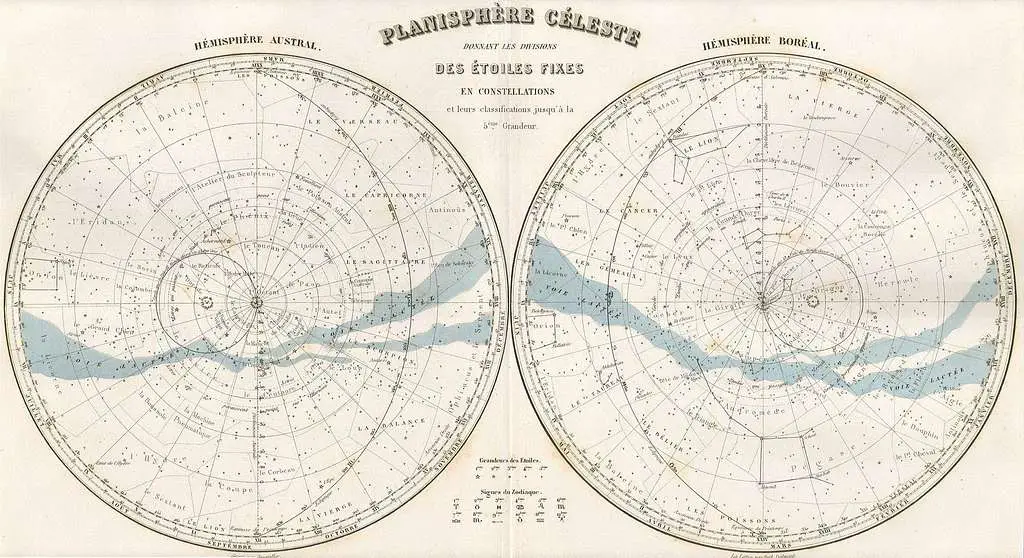For decades, stargazing has been a popular pastime that has captivated people of all walks of life, from amateurs to expert astronomers. Whether you are an avid sky watcher or are just beginning your adventure into the glories of the night sky, you may have come across two crucial tools: star charts and planispheres. Both of these tools are designed to help you navigate the night sky more effectively. There are important distinctions to be made between these two devices, despite the fact that they are both utilized for the aim of assisting us in navigating the celestial sphere. In this piece, we will investigate the differences between the two, as well as determine when each should be used.
Charts of the Stars
Astronomers have been using star charts, which are often referred to as sky maps or celestial atlases, for many centuries to aid them in identifying and locating various objects in the night sky. They present a perspective of the night sky that is both specific and all-encompassing, highlighting the locations of stars, constellations, nebulae, galaxies, and other exciting celestial phenomena.
The majority of the time, star charts are made up of a map of either the entire sky or a particular location, which is then sectioned off into a grid or a set of coordinate lines. Astronomers are able to more accurately locate the location of celestial objects with the assistance of these lines. In addition to this, star charts typically incorporate labels and symbols that depict the many stars, constellations, and other prominent characteristics. Some more sophisticated star charts even include color coding to discern stars according to the magnitude or spectral classification of the star.
Star charts are extremely adaptable; they can be tailored to a region’s latitude, a particular season, or a particular time period. In the fields of astronomy education, astrophotography, and professional research, they are utilized frequently. Star charts, on the other hand, may require some prior knowledge and familiarity with celestial coordinates and nomenclature due to their intricacy and amount of detail.
Planispheres
Planispheres are simplified tools that are used to navigate the night sky. They are also known as star wheels or star maps. Planispheres, on the other hand, are primarily concerned with assisting with the identification of the major constellations and stars that are visible from a given latitude. This is in contrast to star charts, which cover a vast variety of astronomical objects and require expertise with coordinates.
Planispheres are made up of two movable disks that spin in opposite directions against each other. The smaller inner disk has a circular cutout with a window, while the bigger outer disk depicts the section of the sky that may be seen from a specific latitude. This window presents a representation of a section of the sky as it appeared at a specific date and time. A number of concentric circles, often depicting the horizon, cardinal directions, and the position of stars and constellations, are typically found on the outer disk.
In order to make use of a planisphere, you must first align the date and time that is displayed on the outer disk with the position that is displayed on the inner disk. The visible sky is brought into proper alignment for the current moment as a result of the planisphere’s actions. The window will show the constellations and stars that are currently visible from your location as you rotate the inner disk. Since planispheres are so easy to operate, even novices and people who only occasionally look at the stars can benefit from owning one.
Planispheres come in very handy when it comes to learning about and recognizing constellations, keeping track of the movement of stars throughout the night, and organizing stargazing sessions in advance. They allow users to get hands-on experience while also assisting them in understanding how the night sky shifts over time as a result of the rotation of the Earth.
To summarize, despite the fact that both star charts and planispheres are helpful in navigating the night sky, there are notable distinctions between the two in terms of the level of intricacy, the purpose, and the extent of each. The perspective of the celestial sphere that is provided by star charts is more comprehensive and detailed than any other type of celestial map, and it includes a wider variety of heavenly bodies. They are an excellent choice for astronomers, astrophotographers, and other individuals interested in gaining an in-depth knowledge of the night sky.
Planispheres, on the other hand, are more straightforward instruments that concentrate largely on the major constellations and stars that may be seen from a given latitude. They provide an approach to stargazing that is both approachable and hands-on, making them excellent for novices and people who only occasionally look up at the sky.
The awe-inspiring experience of exploring the universe above us is enhanced by the use of either a star chart or a planisphere, regardless of which instrument you choose to employ. Therefore, seize the instrument of your choice, find a dark place outside, and get ready to start on a journey through the heavens that will certainly leave you enthralled by the wondrous things that the universe has to offer.
![]()
